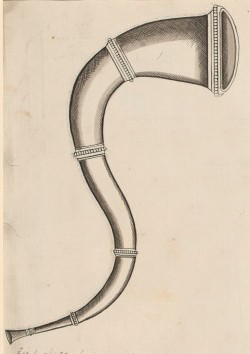
The nansingha or nansinga is a type of primitive trumpet made of copper or copper alloys, used in both India and Nepal. The instrument is made of two metal curves, joined to form an "S" shape. It may also be reassembled to form a crescent.
It is part of a group of curved-tube instruments that include the ransingha, the narsinga and the sringa. It may also be related to the laawaa and Tibetan dungchen, both straight tubular copper horns.
Alternate names
The instrument's name has been variously spelled narsinga, ransingha, ramsinga, and srnga.
Srnga is Sanskrit for horn and used in North India and Nepal. Its modern forms include "Sig", "Siga,", and "Singha". The term was historically used for a wide variety shapes and sizes of horns, including straight horns, and horns made from water buffalo horns with mouthpieces made from ox horns.
Ramsingha

The ramsinga is a pronunciation specific to India. It uses four pipes of very thin metal which fit one within the other. It is mentioned in Emilio Salgari's works such as The Mystery of the Black Jungle (1895), where it is associated with the thugee cult.
In Chapter 62 of Foucault's Pendulum (1988) the Ramsinga is also mentioned, being played by a devotee of a druidic sect .
Narsinga
Played historically in C shape in Nepal by Damai caste musicians in groups such as the damai baja. This form used in Nepal, Himachal Pradesh and southern Bihar. The Narasingha horn is also played by the Gawantaris (musicians) of the Udasi sect of Sikhism to inform the public about religious processions.
-
 Nepal. The C-shaped narsinga is part of the Panche baja instruments.
Nepal. The C-shaped narsinga is part of the Panche baja instruments.
-
 Nepal. Narsinga being played for a wedding.
Nepal. Narsinga being played for a wedding.
-
 Nepal. Narsingas at a wedding party.
Nepal. Narsingas at a wedding party.
-
 Fresco from Thakurdwara Dariana Mal in Amritsar depicting an Udasi playing the Narasingha
Fresco from Thakurdwara Dariana Mal in Amritsar depicting an Udasi playing the Narasingha
See also
References
- Manorma Sharma (1 January 1998). Tribal melodies of Himachal Pradesh: Lahaul Valley. APH Publishing. pp. 64–. ISBN 978-81-7024-942-9. Retrieved 24 March 2012.
- Nikolova, Ivanka; Davey, Laura; Dean, Geoffrey, eds. (2000). The Illustrated Encyclopedia of Musical Instruments. Cologne: Könemann Verlagsgesellschaft mbH. p. 94.
- Alastair Dick (1984). "Śrnga". In Sadie, Stanley (ed.). The New Grove Dictionary of Musical Instruments. p. 442. Volume 3.
- Carol M Babiracki; Mireille Helffer (1984). "Narsīga". In Sadie, Stanley (ed.). The New Grove Dictionary of Musical Instruments. p. 749. Volume 2.
- Teja, Charanjit Singh (27 July 2019). "Meet the family that has been making musical instruments since eight generations". The Tribune. Retrieved 10 August 2023.
| Musical instruments of Nepal | |||||||||||
|---|---|---|---|---|---|---|---|---|---|---|---|
| String |
| ||||||||||
| Wind |
| ||||||||||
| Percussion |
| ||||||||||
| Others | |||||||||||
| Extinct | |||||||||||
| Indian musical instruments | |
|---|---|
| Wind (Sushir) | |
| Plucked Stringed (Tat) | |
| Bowed Stringed (Vitat) | |
| Membranous Percussion (Avanaddh) | |
| Non-Membranous Percussion (Ghan) | |
| Other | |
| Historical/possibly extinct | |
External links
- History of the ransingha or narsinga with photos.
- Ancient musical instruments of India (circa 18th Century) as depicted by Balthazar Solvyns in Les Hindoûs (Indira Gandhi National Centre for the Arts, IGNCA)
This article about the music of India is a stub. You can help Misplaced Pages by expanding it. |
This article relating to brass instruments is a stub. You can help Misplaced Pages by expanding it. |